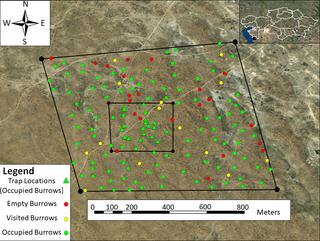PLOS Neglected Tropical Diseases ( IF 3.4 ) Pub Date : 2018-07-25 , DOI: 10.1371/journal.pntd.0006630 David M Poché 1 , Zaria Torres-Poché 1 , Aidyn Yeszhanov 2 , Richard M Poché 1 , Alexander Belyaev 2 , Vit Dvořák 3 , Zaure Sayakova 2 , Larisa Polyakova 1 , Batirbek Aimakhanov 2

|
Plague (Yersinia pestis) and zoonotic cutaneous leishmaniasis (Leishmania major) are two rodent-associated diseases which are vectored by fleas and phlebotomine sand flies, respectively. In Central Asia, the great gerbil (Rhombomys opimus) serves as the primary reservoir for both diseases in most natural foci. The systemic insecticide fipronil has been previously shown to be highly effective in controlling fleas and sand flies. However, the impact of a fipronil-based rodent bait, on flea and sand fly abundance, has never been reported in Central Asia. A field trial was conducted in southeastern Kazakhstan to evaluate the efficacy of a 0.005% fipronil bait, applied to gerbil burrows for oral uptake, in reducing Xenopsylla spp. flea and Phlebotomus spp. sand fly abundance. All active gerbil burrows within the treated area were presented with ~120 g of 0.005% fipronil grain bait twice during late spring/early summer (June 16, June 21). In total, 120 occupied and 14 visited gerbil colonies were surveyed and treated, and the resulting application rate was minimal (~0.006 mg fipronil/m2). The bait resulted in 100% reduction in Xenopsylla spp. flea abundance at 80-days post-treatment. Gravid sand flies were reduced ~72% and 100% during treatment and at week-3 post-treatment, respectively. However, noticeable sand fly reduction did not occur after week-3 and results suggest environmental factors also influenced abundance significantly. In conclusion, fipronil bait, applied in southeastern Kazakhstan, has the potential to reduce or potentially eliminate Xenopsylla spp. fleas if applied at least every 80-days, but may need to be applied at higher frequency to significantly reduce the oviposition rate of Phlebotomus spp. sand flies. Fipronil-based bait may provide a means of controlling blood-feeding vectors, subsequently reducing disease risk, in Central Asia and other affected regions globally.
中文翻译:

在哈萨克斯坦中亚共和国对 0.005% 氟虫腈诱饵(口服给予大鼠)用于控制跳蚤(Siphonaptera:Pulicidae)和白蛉(Diptera:Psychodidae)进行现场评估
鼠疫(鼠疫耶尔森氏菌)和人畜共患皮肤利什曼病(大利什曼原虫)是两种与啮齿动物相关的疾病,分别由跳蚤和白蛉传播。在中亚,大沙鼠( Rhombomys opimus )是大多数自然疫源地中这两种疾病的主要宿主。内吸性杀虫剂氟虫腈先前已被证明对控制跳蚤和白蛉非常有效。然而,中亚地区从未有过关于氟虫腈啮齿动物诱饵对跳蚤和白蛉丰度影响的报道。在哈萨克斯坦东南部进行了一项现场试验,以评估将 0.005% 氟虫腈诱饵施用于沙鼠洞穴进行口服摄取,以评估减少客蜱虫属的效果。跳蚤和白蛉属。沙蝇丰富。在春末/夏初(6 月 16 日、6 月 21 日)期间,对处理区域内所有活跃的沙鼠洞穴两次提供约 120 克 0.005% 氟虫腈颗粒饵料。总共对 120 个被占用的沙鼠群落和 14 个被访问的沙鼠群落进行了调查和处理,所得到的施用量极小(约 0.006 mg 氟虫腈/m 2 )。该诱饵导致异木虱100% 减少。治疗后 80 天跳蚤丰度。治疗期间和治疗后第 3 周,妊娠白蛉分别减少约 72% 和 100%。然而,第三周后并没有出现明显的白蛉减少,结果表明环境因素也显着影响了丰度。总之,在哈萨克斯坦东南部使用氟虫腈诱饵有可能减少或消除异木虱属。 如果至少每 80 天使用一次,则可能会抑制跳蚤,但可能需要以更高的频率使用,以显着降低白蛉属的产卵率。沙蝇。在中亚和全球其他受影响地区,基于氟虫腈的诱饵可以提供一种控制吸血媒介的方法,从而降低疾病风险。













































 京公网安备 11010802027423号
京公网安备 11010802027423号